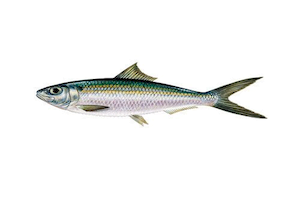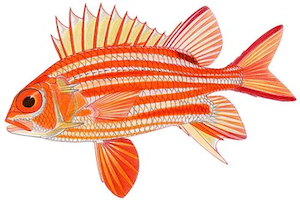Environment: milieu / climate zone / depth range / distribution rangeEcology
Marine; freshwater; brackish; pelagic-neritic; oceanodromous (Ref. 51243); depth range 10 – 100 m (Ref. 5286), usually 25 – 100 m (Ref. 54866). Subtropical; 68°N – 14°N, 32°W – 43°E (Ref. 54866)
DistributionCountries | FAO areas | Ecosystems | Occurrences | Point map | Introductions | Faunafri
Northeast Atlantic: Iceland (rare) and North Sea, southward to Bay de Gorée, Senegal. Mediterranean (common in the western part and in Adriatic Sea, rare in the eastern part), Sea of Marmara and Black Sea.
Length at first maturity / Size / Weight / Age
Maturity: Lm14.8 range ? – ? cm
Max length : 27.5 cm SL male/unsexed; (Ref. 74552); common length : 20.0 cm SL male/unsexed; (Ref. 188); max. reported age: 15 years (Ref. 35388)
Short descriptionMorphology | Morphometrics
Dorsalspines (total): 0; Dorsalsoft rays (total): 13-21; Analspines: 0; Analsoft rays: 12 – 23. Body sub-cylindrical, belly rather rounded (but more compressed in juveniles). Hind margin of gill opening smoothly rounded (without fleshy outgrowths) ; 3 to 5 distinct body striae radiating downward on lower part of operculum; lower gill rakers not becoming shorter at angle of first gill arch, the upper series not overlapping the lower. Last 2 anal fin rays enlarged.
Biology Glossary (e.g. epibenthic)
Littoral species (Ref. 6808). Form schools, usually at depths of 25 to 55 or even 100 m by day, rising to 10 to 35 m at night. Feed mainly on planktonic crustaceans, also on larger organisms. Spawn in batches (Ref. 51846), in the open sea or near the coast, producing 50,000-60,000 eggs with a mean diameter of 1.5 mm (Ref. 35388). Marketed fresh, frozen or canned. Also utilized dried or salted and smoked; can be pan-fried, broiled and microwaved (Ref. 9988).
Life cycle and mating behaviorMaturity | Reproduction | Spawning | Eggs | Fecundity | Larvae
Breeds at 20 to 25 m, near the shore or as much as 100 km out to sea.
Main referenceUpload your references | References | Coordinator | Collaborators
Whitehead, P.J.P., 1985. FAO Species Catalogue. Vol. 7. Clupeoid fishes of the world (suborder Clupeoidei). An annotated and illustrated catalogue of the herrings, sardines, pilchards, sprats, shads, anchovies and wolf-herrings. FAO Fish. Synop. 125(7/1):1-303. Rome: FAO. (Ref. 188)
IUCN Red List Status (Ref. 120744)
Least Concern (LC) ; Date assessed: 20 May 2013
CITES (Ref. 118484)
Not Evaluated
CMS (Ref. 116361)
Not Evaluated
Threat to humans
Harmless
Human uses
Fisheries: highly commercial






























































































































































































































